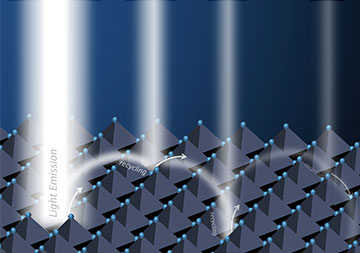
Perovskite can emit additional light by re-absorbing some of the photons it emitted, a process called photon recycling. [Image: Changsoon Cho]
The power-conversion efficiency of perovskite solar cells has soared from 3.8% to 25% in only a decade—approaching the highest recorded efficiency for single-crystalline silicon solar cells, which had a head start of more than a decade. Indeed, scientists now wonder if perovskite solar-cell efficiency may soon reach its theoretical upper bound, the Shockley–Queisser limit, estimated at around 34%.
To push toward the limit, researchers in the United Kingdom, the Republic of Korea and Germany have turned their eyes to some underexplored territory for solar cells: photon recycling and light scattering. The researchers have found that the two processes—photon recycling in particular—play bigger roles in improving light emission of perovskite solar cells than previously believed (Sci. Adv., doi: 10.1126/sciadv.abj1363). And, because high power-conversion efficiency requires that a solar cell be a good emitter as well as a good absorber, the team believes that that closer attention to photon recycling could help future perovskite solar-cell designs draw closer to the theoretical limit.
Brighter emission, better solar cells
The word perovskite comes from the mineral of the same name, whose chemical formula is CaTiO3. The name has evolved to describe compounds with the same crystal structure as the mineral—ABX3, where A is an organic cation, B is metal cation and X is halogen anion. Research into materials with perovskite structure in solar cells has boomed in the last decade or so, thanks to its low manufacturing cost and easy fabrication. But perovskite solar cells haven’t yet reached their full potential (see “Perovskite Photovoltaics: The Road Ahead,” OPN, November 2020).
To improve perovskite solar cells’ efficiency, the international coalition of researchers behind the new study looked into the original prediction of William Shockley and Hans J. Queisser that now defines the theoretical upper limit for solar cells. The Shockley–Queisser theory rests on the idea that, for a solar cell to efficiently convert light into electricity, it must be good at emitting light as well as absorbing it. With some perovskite solar cells now sporting near-unity light absorption efficiencies, the researchers believe improving the light emission of the perovskite solar cell hold what they describe as the “final key” to reaching the Shockley–Queisser limit.
To make that happen, they have turned to light scattering and photon recycling. Changsoon Cho, the study’s first author, was particularly interested in investigating photon recycling—a phenomenon in which a semiconductor such as perovskite re-absorbs a photon it emitted and generates a new photon via photoluminescence. A researcher at the University of Cambridge, UK, Cho had previously studied the role of photon recycling in perovskite LEDs. He performed the research for the new paper while he was at Technische Universität Dresden, Germany.
Scientists have debated just how much photon recycling would contribute in boosting efficiency of solar cells—if it contributes at all. Some have been skeptical of its practical impact, arguing that it’s all theoretical, according to Cho.
New optical model
To study the potential role of photon recycling and light scattering in perovskite photovoltaics, the team first prepared a highly radiative perovskite solar cell with a light emission efficiency of 13.7%. Then, the scientists focused an excitation beam on a spot of the solar cell and measured the photoluminescence at various lateral distances from the spot. This set of measurements confirmed that two phenomena exist in the cell and contribute to its emission efficiency.
But the researchers wanted to take it a step further and calculate just how much the emission increased. So they developed a computational model that could be used to quantify various optical parameters. Previous models have been developed to simulate organic LEDs’ light emission, Cho says, but he and his colleagues had to develop a new one for perovskite solar cells.
The new model suggested that, if photon recycling and light scattering weren’t at play in the cell, its light emission efficiency would have been 3.1% instead of 13.7%. And the team found that the increased light emission boosted the cell’s output voltage by 39 mV and its overall power-conversion efficiency from 23.3% to 24.0%.
“The timing was right”
Cho says that five years ago, the team wouldn’t have been able to conduct this study, as measuring photon recycling’s impact requires a highly efficient, highly emissive solar cell. “The timing was right,” he says. Because of that, he urges others in the field to pay more attention to the phenomenon as well. As the efficiency of the perovskite solar cells increases, the contribution and the importance of light scattering and photon recycling, Cho predicts, will also increase—even beyond what the study reported.
Correction, 26 January 2022, 10:00 EST: This story has been updated to clarify Cho's affiliations.
